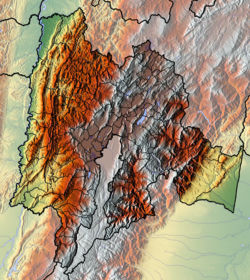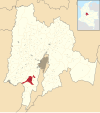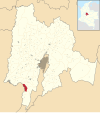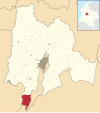Sutagao people
Guayupe, Panche |


The Sutagao lived in the south of the department, including the greyed out southern Bogotá area; Sumapaz

The Sutagao are the
scholar Lucas Fernández de Piedrahita.[2]
Etymology
The name Sutagao is derived from the Chibcha words Su(t)á; "Sun" and gao; "son"; "Sons of the Sun".[1]
Municipalities belonging to Sutagao territories
The Sutagao was a relatively small indigenous group that lived between the Sumapaz Páramo and the Pasca River.
| Name | Department | Altitude (m) urban centre |
Map |
|---|---|---|---|
| Fusagasugá | Cundinamarca | 1756 |  |
| Arbeláez | Cundinamarca | 1417 |  |
| Pandi | Cundinamarca | 1600 |  |
| San Bernardo | Cundinamarca | 1600 |  |
| Venecia | Cundinamarca | 1423 |  |
| Cabrera | Cundinamarca | 2560 |  |
| Sumapaz | Cundinamarca | 3500 |  |
History
Before the
Zipa Saguamanchica conquered the Sutagao around 1470 when the cacique of the Sutagao lost the Battle of Pasca. Conquistador Hernán Pérez de Quesada, brother of Gonzalo Jiménez de Quesada submitted the Sutagao to the new rule of the New Kingdom of Granada.[1]
The Sutagao inhabited the region until a new town was founded by Bernardino Albornoz between 5 and 13 February in 1592. During the visit of Miguel de Ibarra there were 759 indigenous people residing in Fusagasugá.
When Aróstequi arrived in February 1760, the indigenous population had dwindled to 85, and there were 644 new settlers divided among 109 families.
See also
References
- ^ a b c (in Spanish) Indios Sutagaos
- ^ (in Spanish) Los Sutagaos
